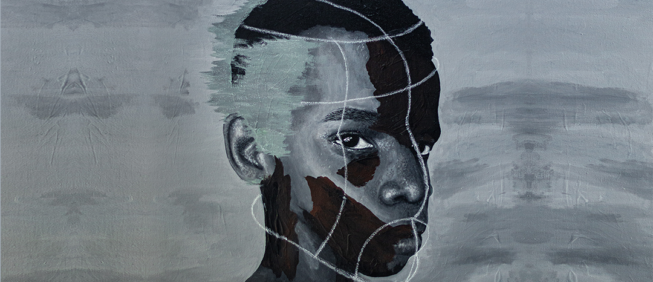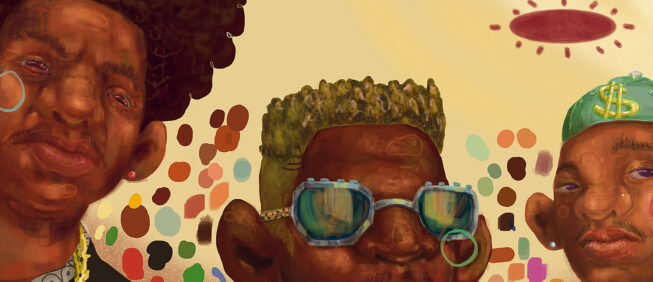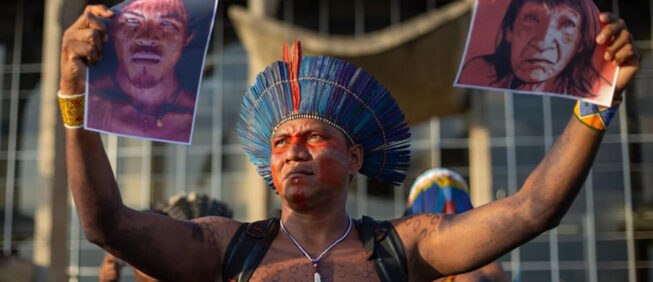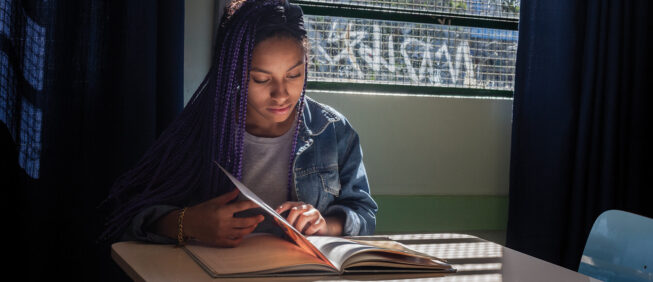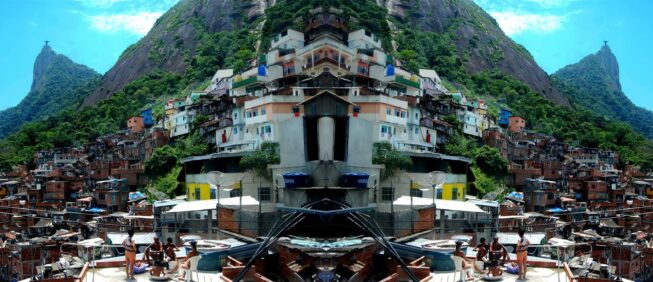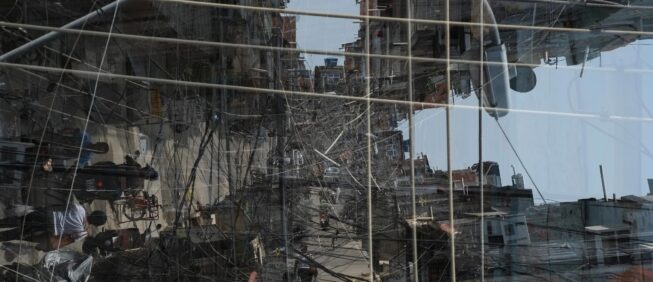Removal
A handful of soil that traveled from Darién to Kumasi
Yolanda Chois Rivera
| Ghana |
6 de October de 2023
We sit on the floor of the room. The house is located in Kumasi, Ghana, inside a compound — typical constructions of this country in which several families have their homes around a common central courtyard. There we were, the translators, an art student, Toafic’s father and me. Six years have passed, this was in January 2017. Moments before entering the house, outside the sun made the terracotta colors of the house vibrate and the red earth floor looked orange, it was a sun made of earth, inside the room the lighting was natural but not much of it came in because the door and the window were closed so as to prevent interruptions. Toafic’s father spoke in Hausa, which is one of the languages spoken in Ghana, mostly by Muslims, a tonal language; its words, the translation into English and then Spanish resulted in very strange sounds, which gave a greater meaning to why I was in Ghana, originally from the Panamanian Darién, over 9000 kilometers away from Kumasi, in 2015, though I could also say that it began in 2014 in Brazil with Toafic’s decision to continue his trip to the north of the continent, I can’t really pinpoint it.
In a press release of April 14, 2023 published by the UNHCR, it was reported that more than 100,000 people crossed into Darién in the first months of 2023, it is estimated that by the end of this year 400,000 people will have crossed. I could not find the number of how many people are estimated to have crossed this jungle since the phenomenon of mass crossing began, which is now at least two decades ago, and which is difficult to specify because not all people are registered and because at the beginning of this phenomenon there was no real monitoring by the authorities.

My intention in writing for the Periferias magazine is to leave something of a person's history inscribed somewhere, transcending the way in which the migration of thousands of people who have crossed the Darién jungle in the last two decades to cross Central America with the aim of reaching the north of the continent: the United States and Canada. In 2014, together with a group of artists, journalists, radio broadcasters, filmmakers, among other professionals, we met to create the artistic and communication project “Towards the Coast: Collective Action”; we were people from Panama and Colombia, interested in the Territorial understanding of the regions that adjoin both countries, specifically on the coast of the Pacific Ocean. We must remember that the American continent is connected from north to south by a highway, the Pan-American Highway, La Panamericana, the only section of which currently not built is the one that connects Panama and Colombia; that is to say, to the south at the center of the continent, in this location, there are two jungle regions of a very important ecosystem, the Chocó jungle (Colombia) and the Darién jungle (Panama). Biologically they are the same, but geopolitically speaking they are divided – this is where you will find the famous Darién Gap. “Towards the Coast” brought together many projects, some of them centered in the history of the violence that happens at the border and that is related to the longstanding Colombian conflict from the 20th century and the beginning of the 21st century; other projects were about the importance of territorial struggles through cultural processes, about food sovereignty among other themes, but we were never able to approach the current reality of the mass migration of Asian, African and Caribbean people and people from countries in this very continent, and for me, this became a pending theme to tackle.
In mid-2015, the news of a group of 5 Ghanaians who drowned in a river in the Panamanian Darién circulated through the national press in Panama – they drowned in the Tuquesa River, a tributary of the Chucunaque River, the largest in Panama. At that time, the idea we had of the people who migrated across that border was that they were all fleeing extreme living conditions: civil wars, hunger, violence. However, there are more variants to consider because this narrative, although true, conceals another problem that concerns us in the societies of the most impoverished countries in the world, and that is the lifestyle paradigm promoted by the mass consumption system in which we live. I began to understand this during my journey. As the projects for “Towards the Coast” were ending, I applied for an artist residency at the Nubuke Foundation, in Ghana, that would allow me to address this “extra-continental migration”, as institutions call it, to work in Ghana, particularly on the case of the 5 migrants who drowned in the Tuquesa River.
I received the news while in Panama: they had accepted my application with a scholarship from the Ministry of Culture of Colombia in association with the Arts Collaboratory platform. This was the last day of July 2016, three days before I had received another news, that of the death of a friend who had recently been my sentimental partner, which meant the mourning I experienced overlapped in a very strange way with the investigation into the deaths of the 5 migrants. At that moment I traveled to Darién, to the cemetery where the bodies of these people are buried, I saw myself one morning sitting next to the grave talking to them and to the person I was mourning, simultaneously — life has strange ways of operating.

The village where they buried their bodies is called Santa Fé; the solemn burial took place in June 2015 as reported by Panamanian newspaper Prensa and was carried out by representatives of the Panamanian institutions responsible for the issue. In this place there is a large tree that guards the graves. Santa Fé is close to the Pan-American Highway, 82 km from the point where the route ends on this side, to restart again in Colombia. In Santa Fé there is a very special place of spiritual growth with a strong social and ecological mission, the house of the Maryknoll mission. I met them through another Panamanian friend and they were very important because they were totally empathetic towards the case of the migrants.
It is not clear for what reason the bodies of these people were buried in that place. Apparently, after being found in the Tuquesa River, they were taken to the capital city and later returned to Darién — the distance from Panama City to Santa Fé is 200 kilometers —, I was told in the investigation, but this can only be verified by tracing the official record that rests in a prosecutor's office in Panama. I stubbornly tried to understand what had happened while trying to design what my work would be in Ghana. The existing information about these deaths is vague, what I found is that they died dragged by the water, during a waterspout, a natural phenomenon in which a large amount of water that was dammed at the head of a mountain precipitates. When that happens, you only have seconds to get out of the river because the water grows quickly taking everything in its path. Some of their names appeared on Ghanaian press websites. They said it was their nicknames. I spoke with as many people as I could in Santa Fé, I spoke with experienced walkers who constantly cross the jungle and I visited their graves, which we cleaned and decorated together with people from the Maryknoll community, several times.
In January 2017 I traveled to Ghana. When I arrived in the capital of Accra to carry out the artistic residence, the foundation that received me organized an agenda of visitations to people and places related to the issue of migration. This schedule was mainly designed by Abdallah Sallisu who I met through Ana Garzón, a colleague and friend from “Towards the Coast”; in June of that same year the three of us would be traveling along the Pan-American highway in Darién facing a disruptive moment. During the first days of the residency, I was assimilating the new context, understanding things that I had perhaps read or heard but with which I had never lived, one of them being the proximity to Muslim communities – Toafic was a Muslim. Near my lodging house, prayers were heard from the Mosque at different times of the day and in a corner of the neighborhood where I stayed, as an encouraging message, there was a large sign from the pub called “Just Believe”.
When this process began in Panama, I wanted to try to contact one of the families of the 5 migrants. Later I understood the insurmountable dimension of this act, how overwhelming it was to arrive at the home of a family like this without a reason. I ignored that idea and basically continued doing interviews, spent the days understanding the streets of Accra, transporting me from the neighborhood where I stayed in Nyamekye to East Legon where the foundation that welcomed me is, a distance of 13 km. Being there and understanding the reality of that context, asking myself questions about the reasons for such a demanding transatlantic trip, thinking about the connection between my cultural context of Colombia and Panama with that of a country on the West African coast, gave me a greater perspective about migration itself but also about the motivations these people had to leave their homes.
One of the problems when observing this kind of migration is the lack of understanding about the motivations behind these journeys; in general we assume that the majority of people who migrate are in conditions of extreme poverty and that they all come from countries where there are no opportunities or a possibility of life, leaving aside other aspects, one of them being the basic right and the ancient human action to migrate, to move from one place to another with the desire to discover the world and seek opportunities.
At present this is only reserved for a small portion of humanity, who has a privileged immigration status, that can afford to pay for that. Should the rest of humanity be confined in their birth place until the moment of their death?
Another dimension of this mobility is the desire to acquire the lifestyle that the consumption system has promoted: we want another life, a well-being that only the global north seems to offer. The problem is not the desire. I think the problem is that participation in this way of life is reserved for a very small part of humanity, although certain sectors of economic power promote the ideas that if we work exhaustively we will obtain that lifestyle and that poverty is practically a choice. Really, the possibility of social mobility in our low-income countries and developing countries is extremely complex; even more so today with the adverse post-pandemic effects.
It is vital to dismantle this way the system operates within us, which makes it difficult for us to recognize other forms of life as valid, other production and consumption systems as possible, and other ways of mutually collaborating between contexts of related problems as a close reality.
Toafic asked for asylum in Brazil, that's what his father told us and what was published in an English news page that spread the news of a mass request for asylum by Ghanaians who traveled for the World Cup in 2014; they were denied asylum, partly because the reasons for which they made the request for asylum were that they were affected by the Muslim religious conflicts in their country, a matter that the Ghanaian government authorities rejected.
The regions of Brazil where the Ghanaians moved after the cup are the regions with the most economic prosperity in the country: São Paulo, Santa Catarina and Rio Grande do Sul. There arises a fundamental point that our colleague Abdallah asked the ombudsman in Metetí, Darién, when we traveled there together, “does this country offer opportunities for migrants to stay?”
Many of the migrants say that it does not matter if they stay in a “transit” country, what they want is to find a place with opportunities; although Latin American countries also have complex socioeconomic problems, the institutional approach of most countries throughout the last decades is to assume that migration is a potential damage. What would happen if instead of traveling to the north of the continent these people decide to stay in Latin American countries? Would we be prepared to assimilate this cultural integration? How would politics and geopolitics change if that happened? What would happen if the main transatlantic deals were not with the North but between countries like Brazil, Ghana, Nigeria, with the Global South? How would our vision of the world and of otherness change and how would the landscape of migration change?
Faced with this denial of asylum, many of them continued to the north of the continent, among them these five people. The news reports that they were in a larger group of different nationalities. I don't know at what point they met each other. In the schedule of interviews that I carried out in Ghana, one was with a young man who lived in Kumasi, named Omar, who had attempted the trip to Europe through Libya and his story was harrowing and important for the understanding of the migratory phenomenon.
We traveled to Kumasi with Stephen, the translator, and there we met Hassan, who was an art student at the time, and his brother. During those conversations, we had moments of hanging out: sitting in the street watching the children play; eating at a local canteen; or just spending time together. In one of those conversations I talked about the story that had brought me there, I showed them one of the news items published on the web, in which the nicknames of three of the five people drowned in the Tuquesa river in Darién were mentioned: Juvi Yung Bacush, Black Prince, Toafic Shamo. When Omar read the news, he reacted strongly and said that he knew one of them, that his family lived near where we were. It was a coincidence that I never expected to happen. Ghana is a country with more than 30 million inhabitants, the possibility that this would happen was almost unlikely, but it did.
The three of them were enthusiastic about the idea of going to look for Toafic's family and although I was nervous, I agreed to that group search mission. When we got home they told us that the father was not there and that we could come back the next day.
We came the next day, stood in front of the entrance to the house, waiting to enter, with the earthen sun illuminating us. We crossed the compound patio and as we sat in the living room, Toafic's father was the first to speak. He told us about life, about his son, about the daughters he had, about the job he had before traveling, he told us about Toafic's trip to Brazil and at what point they stopped receiving calls from him to later receive the news of his death, about how he received the news through another person in the family who worked in a position at the United Nations, he also said that Muslim communities are very close and that a ceremony was held in Panama for his son, and he told us about the group they created there in his community to talk to young people from Muslim schools to persuade them not to make such dangerous trips.
After that, and with the help of Stephen and Hassan, I told them about my experience, I told them about Darién, about the river where that had happened, I told them that the group in which their son was traveling only had one day to go to reach the Pan-American highway – the place where they drowned is close to an Emberá indigenous community called Bajo Chiquito. The number of people crossing through that place has been such that at different times, camps have been set up by humanitarian organizations to provide support to people in transit. I had brought with me some printed photos of the place where they are buried. It is a local Catholic cemetery, and right at the point where they were buried is the big tree that guards the place. His father decided to keep the photo where he can see the big full tree and little tombs with Christian crosses are barely seen.

While in Accra I received a gift from one of the directors of the foundation: it was some seeds from a tree that I could never remember the name of. The Maryknoll sisters insisted on doing symbolic acts to celebrate the memory of the five drowned migrants. Among these actions, I thought of making those seeds germinate and that the tree that grew would be planted there in the place where they were buried since there is no plaque or indication that their remains are there.
Around June 2017 Ana, Abdallah and I organized an event in Panama that brought together people from civil society and humanitarian and state organizations that work in the Darién, to discuss this reality. That event was called “Cayendo a la periferia. Dinámica de la migración”. Ana and Abdalah traveled to Panama for this, after the event we set out on our way to Darién. My idea was to show them all these spaces and people with whom I spoke and thus be able to think together a common strategy to continue addressing the issue. The visit to the Maryknoll house was very significant, they wanted to know and hear what we had to say. We also went to Metetí where we talked with the ombudsman who was present at the solemn burial ceremony of the five people who drowned; in this conversation that Ana was translating into English, she showed us a photo where you can see that the bodies were covered with white sheets. Abdallah told us that this coincidence was very important, the fact that they were covered with white sheets as is done in a traditional Muslim burial, although the ceremony was Catholic, it can be a great symbol for the memory of their relatives.
Our mission at the end of the trip was to plant together the tree that had germinated from the seeds I brought from Ghana. A botanist friend made it grow and it was a strong young tree; Leaving the Ombudsman's Office, we drove back along the Pan-American Highway towards the cemetery, 30 km away by car. The day was ending and we had to return to Panama City (208 km away), but during that first journey, before arriving to plant the tree, the meanings this trip had to each person there, all the accumulated fatigue from the previous work, everything that this process had resulted in, it simply exploded!
In a discussion between English and Spanish, which happened because I didn't want to plant the tree, we passed straight by the cemetery, each one of us crying for different reasons, it got darker and darker and next to us was the little tree... After finishing our trip and saying goodbye, I stayed in Panama a little longer, and returned to the cemetery in Santa Fé to plant the tree on a stormy day. I was accompanied by one of the Maryknolls.
Over time I have returned many times to two memories: in Kumasi at Toafic's parents' house when the father decided to keep the photo of the tree that guards the place where his son was buried, and the moment when the three of us were in the car driving on the Pan-American Highway with the little tree, and we passed by the cemetery. I think about that a lot because I owed my colleagues Abdallah and Ana an apology, but above all because when I was in Ghana I thought about this rhetoric of “global solidarity action”, which is a premise of Zizek's book The New Class Struggle, Refugees and Terror, which we read with some colleagues in Accra, and this in the dimension of ordinary people originating from chaotic countries with civil conflicts, inequalities and more, like us, perhaps it translates into fighting, yes!, but for closing the distance gap between our local realities, relating to people culturally so distant from us living in the same territory and allowing ourselves the opacity of others, as Glissant named it in The Right to Opacity. Poetics of the Relationship. Opacity is what we cannot fully understand in others, but not because we cannot understand it is a threat; not because we cannot understand the presence of these migrant communities in our places means a threat. Unlocking that individual reality is an urgent way to shape what as societies we demand of the rulers, who clearly, together with the international community, have the real possibility of transforming that reality.
Maybe I only went to Ghana to bring a photo to a person and to turn the earth looking for a story, but the transformation that that time in Ghana made in me is forever.
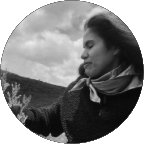
Yolanda Chois Rivera | COLOMBIA |
Since 2014, she has been working between Panama and Colombia, developing projects from the cultural and educational field that have revolved around relationships territorial, migratory and environmental, specifically in the Pacific region that connects the two countries.


